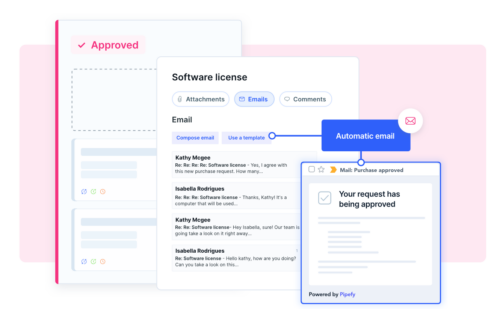ARTICLE SUMMARY
Process orchestration creates harmony among workflows, tasks, processes, and automations.

All about process orchestration
In a post-pandemic world where remote/hybrid work is here to stay, digital transformation is widespread. Customers tend to set higher standards for services and products, making process orchestration an essential practice for companies to remain competitive and efficient.
International Data Corporation (IDC), for instance, predicts that 75% of organizations will have digital transformation implementation roadmaps by 2023, up from 27% registered in 2020. This trend will result “in true transformation across all facets of business and society,” the report suggests.
In this article, we’ll explain the meaning of process orchestration, its benefits, and how it can be implemented to streamline and harmonize the processes in your organization.
What is process orchestration?
The meaning of process orchestration is the coordinating, synchronizing, and monitoring of multiple automated workflows in an organization. This strategy ensures these workflows are operating smoothly and guarantees the expected results for each process. Similar to an orchestral group, in which musicians collaborate and play according to their tempo, so the melody progresses as intended.
When it comes to process orchestration, we are not talking about isolated or fragmented automation usually applied to reduce the time spent on certain tasks in some departments. Instead, it’s about implementing a strategy for connected automations, fostering collaboration and better communication between different teams.
When orchestrating processes, leaders must take into account a holistic view of all execution. This is possible by adopting a platform that integrates all software or applications used across different teams, according to their needs.
Thus, all information and flows of a company are gathered into a single platform, ensuring more standardization and fewer errors.
Orchestration vs. automation
The main difference between process orchestration and process automation lies in the holistic approach of handling connectable processes. Therefore, orchestration takes place when the analysis relies on the whole, and not just individual components. This business practice seeks to identify how to optimize the entire suite of processes through improvements to individual processes (or how they connect to each other).
Automation, on the other hand, represents a technological solution for an individual task or activity. It enables an action that would be performed manually to be executed by a machine — usually software or an application. See below what setting an automation trigger looks like in a no-code software:

With automation, professionals can save time and prioritize tasks that require the unique analytical and creative skills of a human being. Additionally, it’s easier to avoid mistakes that threaten a process’s ability to run smoothly.
However, automation alone doesn’t guarantee long-term positive results, especially when they are not fully aligned with other processes. Data-driven and holistic-oriented decisions must be made to integrate these automations efficiently.
Think about two different processes ran by an HR team: the hiring process and the employee’s onboarding process. An automation designed to improve a particular activity in one of these workflows is likely to impact the other. Case in point, you may not need to collect important information during onboarding because requesting this information has been automated during the hiring process.
These interactions between workflows can also happen between different departments of the same company. Better results can be achieved through a holistic strategy for digitalization and more integration between the workflows. That’s why companies are moving from simply deploying automations to orchestrating them.
According to Forrester, up to 30% of organizations in 2021 will ramp up their focus on process quality by better planning and testing their automations before rolling them out.
Why companies should pursue process orchestration
There are several reasons for companies to strive towards business process orchestration. Nowadays, this solution is a game-changer for almost all industries. Here are some examples of why you should invest in process orchestration:
- Increased adoption of remote work. We all know that strategies adopted during the pandemic are here to stay. Remote and hybrid work models remain largely adopted, requiring sharp decision-making to ensure employee productivity, information security, and fewer communication cracks.
- Demand for customer-focused agility. Online shopping has set a faster pace, both when it comes to service and product delivery. To boost deliveries without hurting quality, companies will need to pursue ways to accelerate flows and prevent bottlenecks that can disrupt the customer’s journey.
- Optimize existent automation. Make the most of the automation you already have and the citizen developers you can count on within your teams. Well-designed automation can save money and time across the company, even in departments directly involved with the automated action.
- Competitive business environment. Companies are working around the clock to promote digital transformation — by 2022, 70% of all organizations will have accelerated use of digital technologies, IDC forecasts. Ignoring process orchestration would be a costly mistake.
7 outcomes of process orchestration
By promoting process orchestration in your organization, your teams can streamline their operations and achieve multiple benefits. Some of them are:
- Cost reduction. By avoiding rework, you can save paid working hours. Additionally, through end-to-end transparency, it gets easier to identify pain points where there’s a loss of resources and how to resolve them.
- Less human mistakes. Well-planned automation eliminates the chance of human errors, which can happen even among top performers.
- Increased collaboration. By connecting platforms and systems used in different departments, your teams will be able to communicate better and work together to achieve common goals.
- Higher employee satisfaction. Less repetitive and manual tasks will release your employees to more elaborate projects, helping them feel more valuable to the company.
- Enhanced customer satisfaction. Error-proof synchronized workflows accelerate deliveries without harming the quality of the services/products delivered. This faster service time will definitely wow your customers.
- Data-driven decisions. Orchestration enabled by proper software will generate insightful data about your processes. Track your performance and watch your progress closely in order to maintain continuous improvement.
- Scalable operation. When you have well-connected automated workflows, you don’t necessarily need to hire more employees to scale up. Let a digital workforce support your growth and enable a scalable production.
How to start orchestrating your processes
To start the process orchestration of your company, you need to choose the proper tool. The software should not only enable task automation, but also allow for process management and workflow building. No-code software will make these achievements easier to accomplish.
Business process platforms that don’t require any coding knowledge allow citizen developers to design, implement, and monitor robust business processes with drag-and-drop fields and features. An efficient no-code solution should also offer:
| Multiple integrations | Multiple integrations. Connect all platforms, apps, and even legacy systems to your no-code solution, ensuring communication between departments and their respective workflows. |
| Attentive support | No-code orchestration tools normally maintain a dedicated Customer Success team, ready to jump in and help your company to make the most out of the platform. |
| Scalability | A good tool is capable of supporting all sizes of operations, from small businesses to complex enterprises. |
| Ready-to-use templates | It gets easier to start when the chosen solution offers an enormous set of templates, tailored according to each team’s processes. |
| Customization capacity | Templates are useful, but a good tool must also offer customization capacity, allowing you to design processes — like online request forms — from scratch. |
Leveraging Pipefy for process harmonization
Pipefy is a no-code/low-code software that allows businesses to design, implement, and connect automated workflows, making business process orchestration faster and simple. Its holistic approach benefits the entire set of operations a company has, from HR teams to procurement processes.
With a user-friendly interface, Pipefy offers hundreds of ready-to-go templates, increases visibility, and generates complete data reports based on the performance of your processes. By adopting Pipefy, many companies have already found success:
- A leading vehicle glass repair and replacement company automated it’s HR processes and reduced in 80% the time to fill urgent job openings.
- Gympass, a multinational wellbeing platform, automated multiple processes, saving 11,000 working hours per month.
- Wiprom, a leading global information technology, reduced its process development and design time by nearly 95%, modeling some workflows in only 20 minutes.
Leverage a scalable orchestration tool to standardize your processes and guarantee error-proof operations. Create a Pipefy’s free account and see how digital transformation can revolutionize your business!






